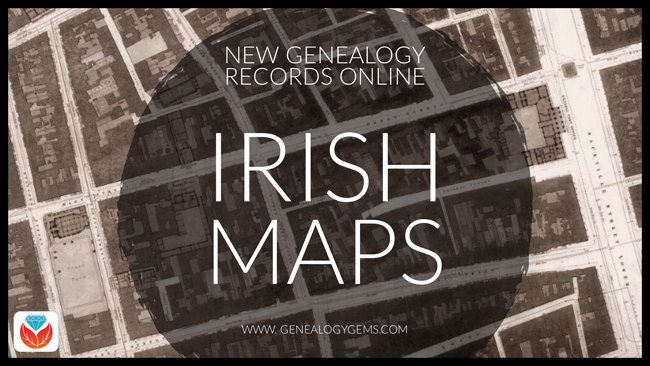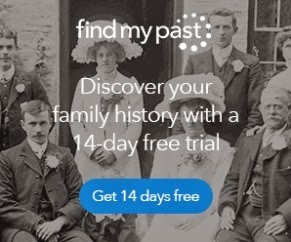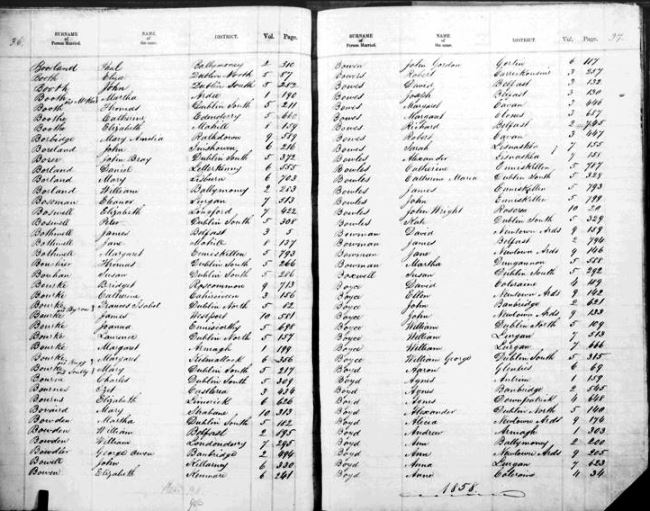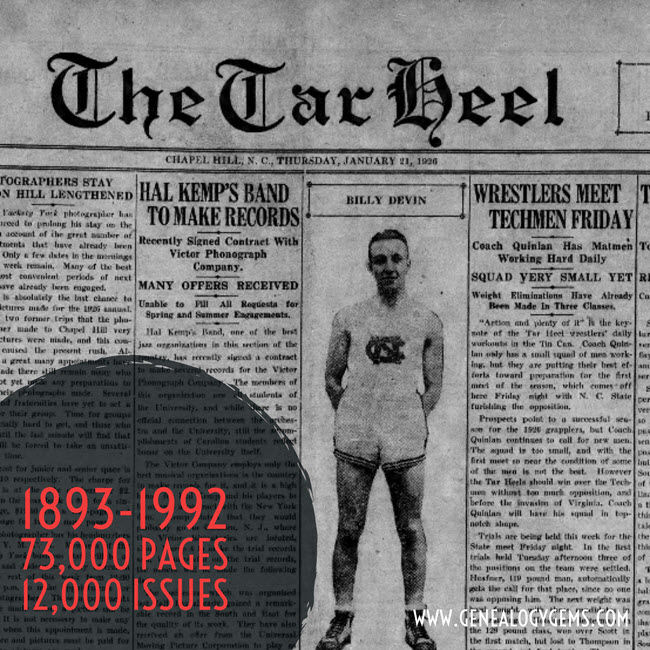by Lisa Cooke | Jul 21, 2017 | 01 What's New, British, Irish, Maps, Records & databases
Digitized Irish historical maps are among new genealogy records online. Also: Irish civil registrations; Irish, British, and Scottish newspapers; Westminster, England Roman Catholic records; wills and probates for Wiltshire, England and, for the U.S., WWI troop transport photos, Tampa (FL) photos, Mayflower descendants, NJ state census 1895, western NY vital records, a NC newspaper, Ohio obituaries, and a Mormon missionary database.

Beautiful Irish historical maps
 Findmypast.com has published two fantastic new Irish historical map collections:
Findmypast.com has published two fantastic new Irish historical map collections:
- Dublin City Ordnance Survey Maps created in 1847, during the Great Famine. “This large-scale government map, broken up into numerous sheets, displays the locations of all the streets, buildings, gardens, lanes, barracks, hospitals, churches, and landmarks throughout the city,” states a collection description. “You can even see illustrations of the trees in St Steven’s Green.”
- Ireland, Maps and Surveys 1558-1610. These full-color, beautifully-illustrated maps date from the time of the English settlement of Ulster, Ireland. According to a collection description, the maps “were used to inform the settlers of the locations of rivers, bogs, fortifications, harbors, etc. In some illustrations, you will find drawings of wildlife and even sea monsters. Around the harbors, the cartographers took the time to draw meticulously detailed ships with cannons and sailors. Many of the maps also detailed the names of the numerous Gaelic clans and the lands they owned, for example, O’Hanlan in Armagh, O’Neill in Tyrone, O’Connor in Roscommon, etc.”
(Want to explore these maps? Click on the image above for the free 14-day trial membership from Findmypast.com!)
More Ireland genealogy records

Sample page, Ireland marriage registrations. Image courtesy of FamilySearch.
FamilySearch.org now hosts a free online collection of Ireland Civil Registration records, with births (1864-1913), marriages (1845-1870), and deaths (1864-1870). Images come from original volumes held at the General Register Office. Click here to see a table of what locations and time periods are covered in this database. Note: You can also search free Irish civil registrations at IrishGenealogy.ie.
New at the British Newspaper Archive
The Irish Independent, a new national title for Ireland, is joined in the Archive this week by eight other brand new titles. These include four titles for Scottish counties: Aberdeenshire, Lanarkshire, Angus (Forfanshire) and Wigtownshire. There are also four new papers for England, two of which are from London (Fulham & Hampstead), one for Worcestershire and one for West Yorkshire. Also, significant additions have been made to the British Newspaper Archive’s online coverage for the Brechlin Advertiser (Scotland, added coverage for 1925-1957) and Southend Standard and Essex Weekly Advertiser (added coverage for 1889-1896).
Roman Catholic Records for Westminster, England
Over 121,000 new Roman Catholic parish records for the Diocese of Westminster, England are now available to search on Findmypast.com in their sacramental records collections:
- Parish baptisms. Over 94,000 records. The amount of information in indexed transcripts varies; images may provide additional information such as godparents’ names, officiant, parents’ residence, and sometimes later notes about the baptized person’s marriage.
- Parish marriages. Nearly 9,000 additional Westminster records have been added. Transcripts include couples’ names, marriage information, and father’s names. Original register images may have additional information, such as names of witnesses and degree of relation in cases of nearly-related couples.
- Parish burials. Transcripts include date and place of burial as well as birth year and death; images may have additional information, such as parents’ names and burial or plot details.
- Additional congregational records. More than 16,000 indexed records of confirmations, donations, and other parish records are included here.
London Marriage Licences 1521-1869
Findmypast has published a searchable PDF version of a published volume of thousands of London Marriage Licenses 1521-1869. Search by name, parish, or other keyword. A collection description says, “Records will typically reveal your ancestor’s occupation, marital status, father’s name, previous spouse’s name (if widowed) and corresponding details for their intended spouse.” Note: The full digital text of this book is free to search at Internet Archive.
Wills and Probate Index for Wiltshire, England
Explore more than 130,000 Wiltshire Wills and Probate records in the free Findmypast database, Wiltshire Wills and Probate Index 1530-1881. “Each record consists of a transcript that will reveal your ancestor’s occupation, if they left a will and when they left it,” says a description. “The original Wiltshire wills are held at the Wiltshire and Swindon Archive. The source link in the transcripts will bring you directly to their site where you can view their index and request an image. If you wish to view an image, you will have to contact Wiltshire Council and a small fee may be required for orders by post.”
New records across the United States
WWI: Ancestry.com subscribers may now access a new online collection of photographs of U.S., WWI Troop Transport Ships, 1918-1919. Browse to search by ship name.
Florida. The city of Tampa, Florida has digitized and published two historic photo collections on Hillsborough County Public Library Cooperative Digital Collections:
- The Greater Tampa Chamber of Commerce Collection includes over 30,000 images of Tampa events dating from about 1950 until 1990, and includes many local officials and dignitaries.
- The Tampa Photo Supply Collection includes more than 50,000 images of daily life and special events (weddings, graduations) taken by local commercial photographers between 1940 and 1990, primarily in West Tampa, Ybor City, and South Tampa.
Mayflower descendants. AmericanAncestors.org has published a new database of authenticated Mayflower Pilgrim genealogies: Mayflower Families Fifth Generation Descendants, 1700-1880. The collection includes the carefully-researched names of five generations of Mayflower pilgrim descendants.
New Jersey. The New Jersey State Census of 1895 is now free to search at FamilySearch.org, which also hosts an 1885 New Jersey state census collection. “The state of New Jersey took a state census every 10 years beginning in 1855 and continuing through 1915, says a FamilySearch wiki entry. “The 1885 census is the first to survive in its entirety.” Click here to learn more about state censuses in the United States.
New York. Ancestry.com has published a searchable version of a genealogy reference book, 10,000 Vital Records of Western New York, 1809-1850. According to a collection description, “The 10,000 vital records in this work were drawn from the marriage and death columns of five western New York newspapers published before 1850….Birth announcements were not published in these early newspapers, but many of the marriage and death notices mentioned birth years, birthplaces, and parents’ names, and where appropriate such data has been copied off and recorded here.”
North Carolina. The first 100 years of the Daily Tar Heel newspaper are now free to search in digitized format at the North Carolina Digital Heritage Center. The collection spans 1893-1992 and includes over 73,000 pages from more than 12,000 issues. Click here for a related news article.

Ohio. FamilySearch also now hosts an index to Ohio, Crawford County Obituaries, 1860-2004, originally supplied by the county genealogical society. Obituaries may be searched or browsed; images may include additional newspaper articles (not just obituaries).
Utah and beyond (Latter-day Saint). The Church of Jesus Christ of Latter-day Saints (Mormons) has published a database of early missionaries. It covers about 40,000 men and women who served between 1830 and 1930, and may link to items from their personal files, including mission registry entries, letters of acceptance, mission journal entries, and photos. Those who are part of FamilySearch’s free global Family Tree will automatically be notified about relatives who appear in this database, and may use a special tool to see how they are related. Others may access the original database here. Click here to read a related news article.
Keep up with new and updated genealogy records online by subscribing to our free weekly email newsletter!

Disclosure: This post contains affiliate links and Genealogy Gems will be compensated if you make a purchase after clicking on these links. Thank you for supporting Genealogy Gems!
by Lisa Cooke | Oct 19, 2015 | 01 What's New, Ancestry, NARA
The US National Archives has signed agreements with FamilySearch and Ancestry to put more of the Archives’ unique genealogical treasures online. We think that’s worth shouting about!
The National Archives has been working with FamilySearch and Ancestry for years to digitize genealogical treasures from its vaults. Contracts have been signed to continue efforts with both partners to digitize even MORE genealogy records at the National Archives: MORE birth, marriage, death, immigration and military service records! Here are some highlights from the contract:
1. Partners will now “be able to post segments of large collections immediately, rather than waiting for the entire collection to be completed.” This sounds familiar to users of FamilySearch, which regularly dumps un-indexed chunks of digitized content onto its site just to make it available faster.
2. The updated agreement contains provisions to protect “personally identifying information.”
3. Ancestry will have a shorter time period (by 12-24 months) during which they have exclusive rights to publish the images together with the index. After that, the National Archives can put the material on its site and/or share it with other partners.
4. The National Archives “will continue to receive copies of the digital images and metadata for inclusion in its online catalog….The public will be able to access these materials free of charge from National Archives research facilities nationwide [not online]. Ancestry.com makes the digitized materials available via subscription.”
What kind of data is already online from The National Archives?
FamilySearch and Ancestry already host digital images of millions of National Archives documents: U.S. federal censuses. Passenger lists. Border crossings. Naturalization records. Compiled military service records. Freedman’s Bank and Freedmen’s Bureau records (the latter are currently being indexed). Federal taxation records. And the list goes on! According to the press release, before these partnerships began, “many of these records were only available by request in original form in the research rooms of the National Archives.”
Click here  to search all the National Archives content on Ancestry (more than 170 million images; subscription required to view).
to search all the National Archives content on Ancestry (more than 170 million images; subscription required to view).
Just in case you’re wondering (and I was wondering), The National Archives isn’t playing favorites with their partnerships. This list shows that a National Archives partnership is pending with Findmypast. They’re already working with Fold3. I wasn’t surprised to see the John F. Kennedy Library on their list, but I wouldn’t have guessed the Royal Commission on the Ancient and Historical Monuments of Scotland!
Click to read more National Archives gems on our website:
Celebrate the U.S. Constitution with National Archives Resources
National Archives Digitizing Projects: Colonial, WWII, Jewish and More
National Archives Regional Facilities Closing or Consolidating
by Lisa Cooke | Jul 28, 2017 | 01 What's New, Australian, Canadian, FamilySearch, Irish, Italian, Records & databases
Free genealogy records, newly available online, may be able to take you around your ancestor’s world! This week’s record destinations include Australia, Belgium, Brazil, Bolivia, Canada, Chile, Dominican Republic, France, Italy, Netherlands, Nicaragua, Russia, and South Africa.

Civil registration records–key genealogical resources–from several countries are among the free new family history records online in recent days and weeks. But you’ll also find probate records, church records, military personnel records, and even a digital archive meant to preserve ancient aboriginal languages. Which might mention your ancestors?
Argentina
Over 100,000 indexed names have been added to FamilySearch’s free collection, Argentina, Entre Ríos, Catholic Church Records, 1764-1983. According to a collection description, it includes “baptisms, confirmations, marriages and burials for cities in the province of Entre Ríos.”
Australia
An exciting new Australian website houses a digital archive of Aboriginal and Torres Strait Islander language materials. It includes texts, audio, video, and ebooks about Australia’s First Nations languages. The hope of the site is to be a digital repository for gathering, preserving, and sharing materials that in effect preserve these languages and revitalize their use. The site managers will continue to work with partners to bring more content to the site. Click here to read more about the site’s launch, and click here to access it directly.
Belgium
Two free Belgian civil registration collections at FamilySearch.org have been updated:
Both of these collections are comprised of civil registration of births, marriages, and deaths from the Belgium National Archives, as well as marriage proclamations, marriage supplements, and some original indexes. Additional images will be added as they become available.
Brazil
Several free Brazilian genealogy records collections have been updated at FamilySearch.org. Among them are the following:
- Pernambuco, Civil Registration, 1804-2014 (more than 300,000 newly indexed records)
- Piauí, Civil Registration, 1875-2013 (nearly 150,000 newly indexed records)
- Brazil, São Paulo, Immigration Cards, 1902-1980 (over 20,000 newly indexed records)
Bolivia
Over 300,000 indexed names have been added to FamilySearch.org’s enormous free collection of Bolivia Catholic Church Records, 1566-1996. The collection hosts over 1.5 million digitized images of Catholic Church records created by parishes in Bolivia. “These records include: baptisms, confirmations, marriages, pre-marriage investigations, deaths, indexes and other records. Some of these records have been indexed and are searchable as part of this collection. Additional indexed records will be published as they become available.”
Canada
Library and Archives Canada continues to update its free Personnel Records of the First World War database. So far, the database includes “digitized files for many individuals of the Canadian Expeditionary Force and the Royal Newfoundland Regiment and Newfoundland Forestry Corps (courtesy of the Rooms Provincial Archives).”
Newly digitized CEF files are added to the references every two weeks, states the collection’s landing page. To date, over 461,000 of an expected 640,000 files have been added. “Library and Archives Canada is digitizing the service files systematically, from box 1 to box 10686, which roughly corresponds to alphabetical order,” explains a blog post. “Please note that over the years, the content of some boxes has had to be moved and, you might find that the file you want, with a surname that is supposed to have been digitized, is now located in another box that has not yet been digitized.”
Chile
FamilySearch.org has updated its free collection, Chile Civil Registration, 1885-1903. These include “births, marriages, and deaths for various localities in Chile from 1885 to 1903. For a complete list of all the provincias and comunas included in this collection, see the Provinces of Chile – Civil Registration coverage table. Only records from a few localities have been indexed. More records and images will be added as they become available.” Need help reading these? FamilySearch suggests using this Spanish Genealogical Word List, which also links to other translation tools.
Dominican Republic
Over 175,00 indexed names have been added to FamilySearch’s free collection, Dominican Republic Civil Registration, 1801-2010. Spanning over 200 years, the collection includes images of births, marriages, and deaths as well as some divorces and indexes. “Some of these records have been indexed and are searchable as part of this collection,” states the collection description. “Additional images and indexed records will be published as they become available. These records were obtained from public access sources in the Dominican Republic.”
France
FamilySearch has updated its collection of indexed Catholic parish record images for Coutances et d’Avranche Diocese, 1533-1894. Baptisms, marriages, and burials are all included. “Parishes within this diocese are within the boundaries of the department of Manche,” states a collection description. “French commission for Informatics and Liberties (CNIL) does not allow publication of sensitive data below 150 years.”
Italy
FamilySearch continues to publish more Italian civil registration records! These are some of the latest:
Netherlands
Just shy of a million records have been added recently to FamilySearch’s free collection, Netherlands, Archival Indexes, Miscellaneous Records. “Archives around the Netherlands have contributed indexes which cover many record sources, such as civil registration, church records, emigration lists, military registers, and land and tax records,” says the collection description. “These records cover events like birth, marriage, death, burial, emigration and immigration, military enrollment and more. These indexes were originally collected, combined and published by OpenArchives.”
Nicaragua
There are now over two century’s worth of records in the free FamilySearch collection, Nicaragua Civil Registration, 1809-2013. It includes “births, marriages, deaths, and other records created by civil registration offices in various departments of Nicaragua.” Civil registration in Nicaragua didn’t begin until 1879, and it appears that most records in this collection date from that year or later.
Paraguay
Nearly 125,000 browse-only images have been added to FamilySearch.org’s free collection, Paraguay Miscellaneous Records, 1509-1977. According to the site, “These records include two complete collections: Sección Nueva Encuadernación (Rebinding Section) and Sección Propiedades y Testamentos (Properties and Wills Section). Copies of the original records are housed at the Archivo Nacional in Asunción, Paraguay. The “Propiedades y Testamentos” section can give a brief look at the personal wealth of clerics, economic bases of resident foreigners in Paraguay, or the fortunes of a given family over a period of time.”
Russia
FamilySearch.org has updated its free collection, Russia, Samara Church Books, 1779-1923. It includes “images and partial index to records of births and baptisms, marriages, deaths and burials performed by priests of the Russian Orthodox Church in the province of Samara. These records were acquired from the state archive in that province.” Another brief statement in the collection description illustrates the incremental and ongoing nature of record additions to FamilySearch: “Currently this collection is 4% complete. Additional records will be added as they are completed.”
South Africa
Over 40,000 indexed records have been added to the free FamilySearch.org collection, South Africa, Transvaal, Probate Records from the Master of the Supreme Court, 1869-1958. The records are described simply as “probate records from the Master of the Supreme Court, Transvaal, South Africa. Original records are located in the Transvaal Archives Depot, Pretoria, Republic of South Africa.
Spotlight on probate records
 Probate records detailed the final settling of our ancestors’ financial assets. They often contain rich genealogical information and interesting insights into a person’s life. They are among the many records you might find at courthouses and government archives. More U.S. probate records are coming online (click here to learn more), but even if you have to visit a courthouse yourself or hire someone to do it for you, it’s often worth it. Click here to read why.
Probate records detailed the final settling of our ancestors’ financial assets. They often contain rich genealogical information and interesting insights into a person’s life. They are among the many records you might find at courthouses and government archives. More U.S. probate records are coming online (click here to learn more), but even if you have to visit a courthouse yourself or hire someone to do it for you, it’s often worth it. Click here to read why.
Thanks for sharing this post with those who will want to know about these free genealogy records online!


 Findmypast.com has published two fantastic new Irish historical map collections:
Findmypast.com has published two fantastic new Irish historical map collections:




 Probate records detailed the final settling of our ancestors’ financial assets. They often contain rich genealogical information and interesting insights into a person’s life. They are among the many records you might find at courthouses and government archives. More U.S. probate records are coming online (
Probate records detailed the final settling of our ancestors’ financial assets. They often contain rich genealogical information and interesting insights into a person’s life. They are among the many records you might find at courthouses and government archives. More U.S. probate records are coming online (